Abstract
Some functions of monocytes (phagocytosis, bactericidal capacity, handling of endocytosed 51Cr-SRBC and chemotaxis) were studied in fifty patients with solid tumours and in fifty controls. In the presence of autologous serum, the catabolism of endocytosed 51Cr-SRBC and the phagocytic capacity were similar in tumour and control monocytes, while the bactericidal capacity of tumour monocytes was increased. In the presence of pooled AB sera the catabolism and the bactericidal capacity were decreased in tumour monocytes as compared with autologous serum. Tumour sera did not enhance the functions of normal monocytes. Inactivation of pooled tumour or AB sera resulted in decrease of bactericidal capacity in tumour and control monocytes. Using the Clq-binding test, we detected circulating immune complexes in 36% of sera. The presence or absence and the quantity of such complexes did not correlate with the different functions studied in either tumour or normal monocytes. Finally, the chemotactic activity of monocytes was studied using the migration under agarose technique. No difference was found between tumour and control monocytes. On the other hand, the presence of a chemotactic inhibitor was not revealed in tumour sera. These observations suggest that monocytes from tumour patients require factor(s) present in autologous serum as well as autologous cellular component(s) to achieve normal functions.
Full text
PDF
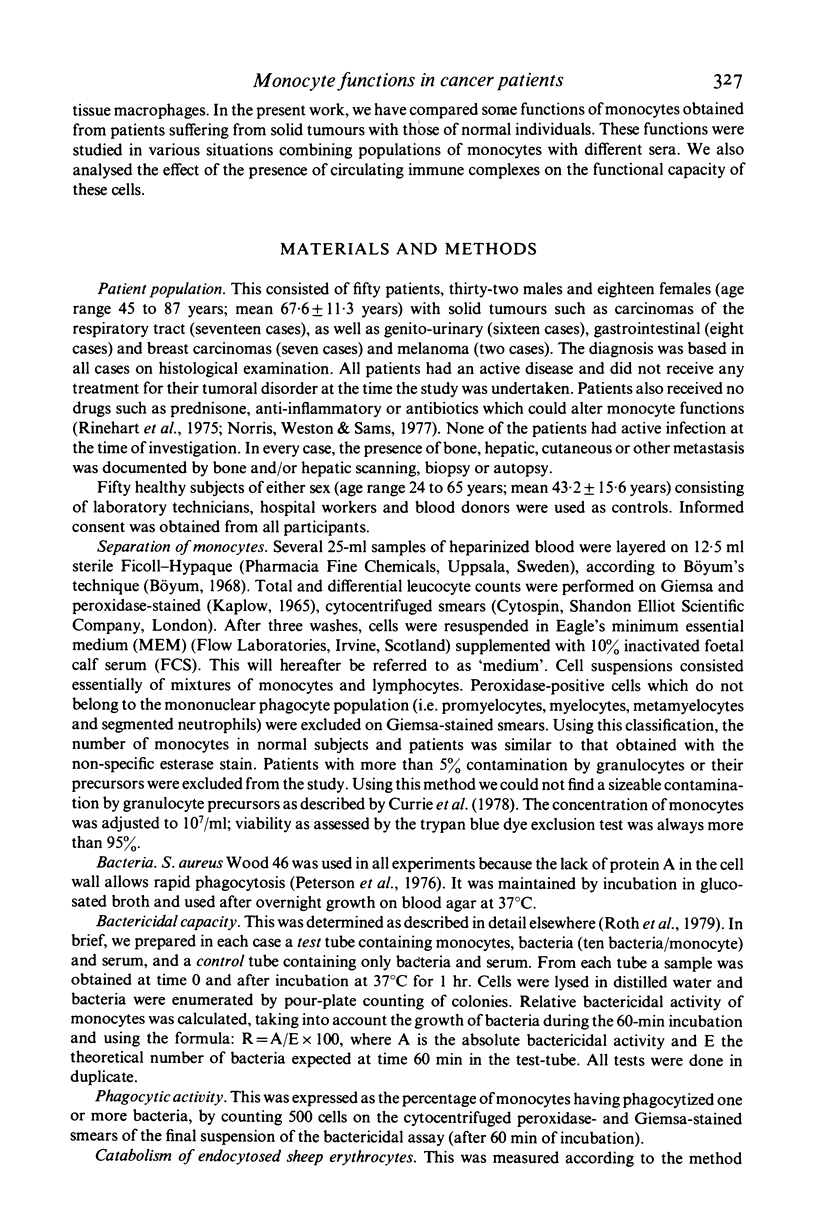
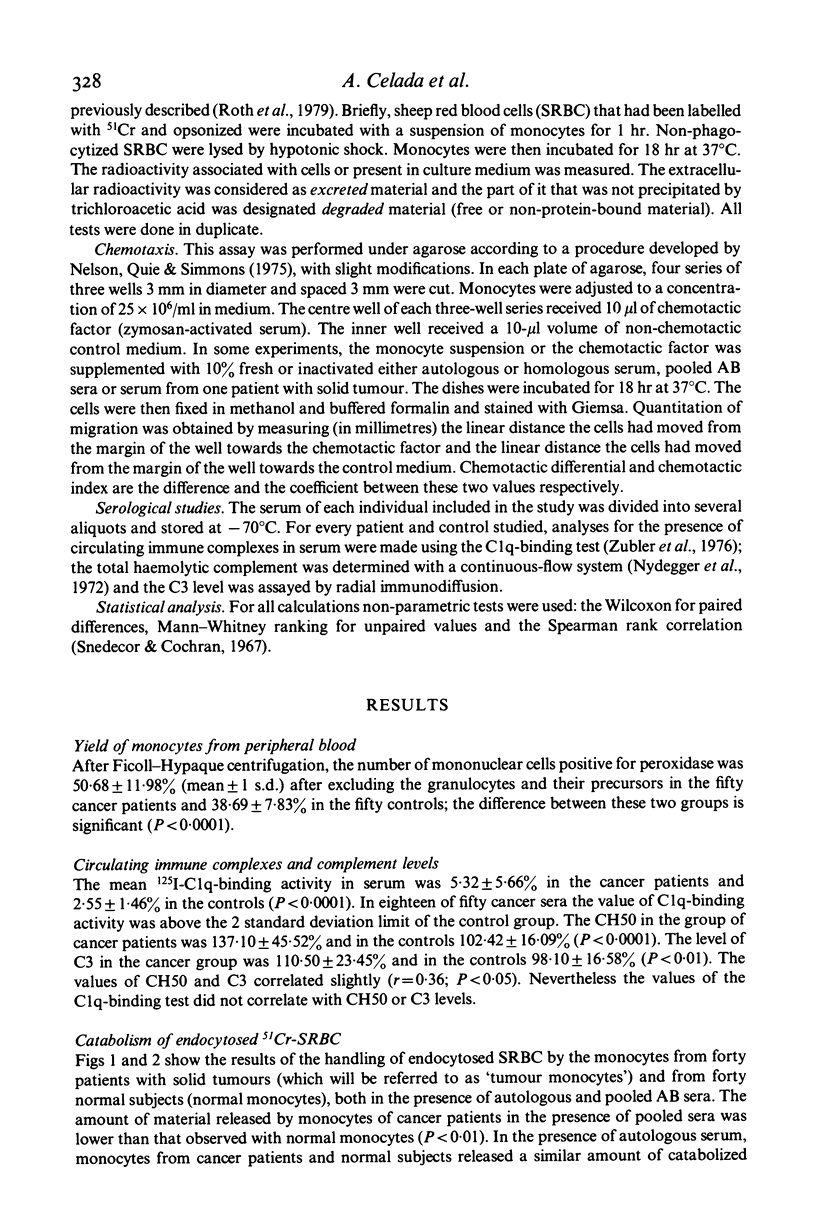
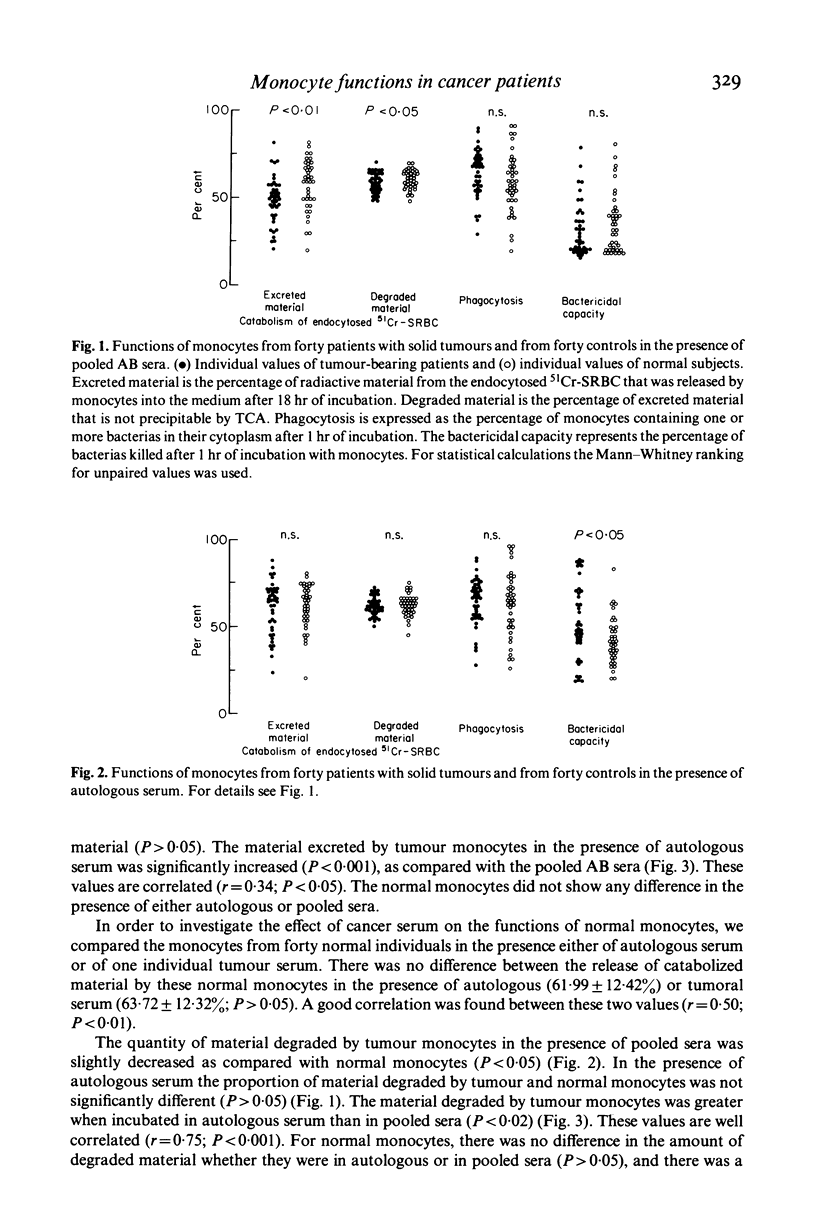
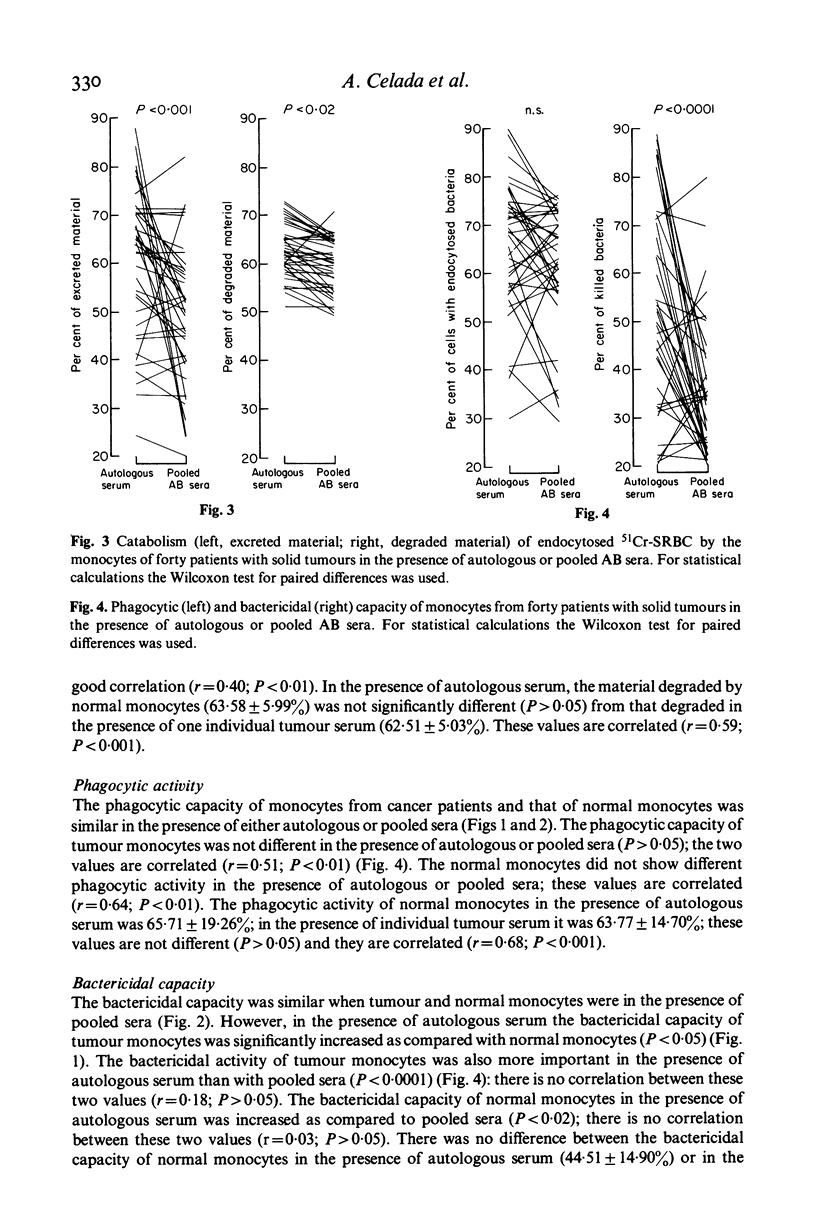

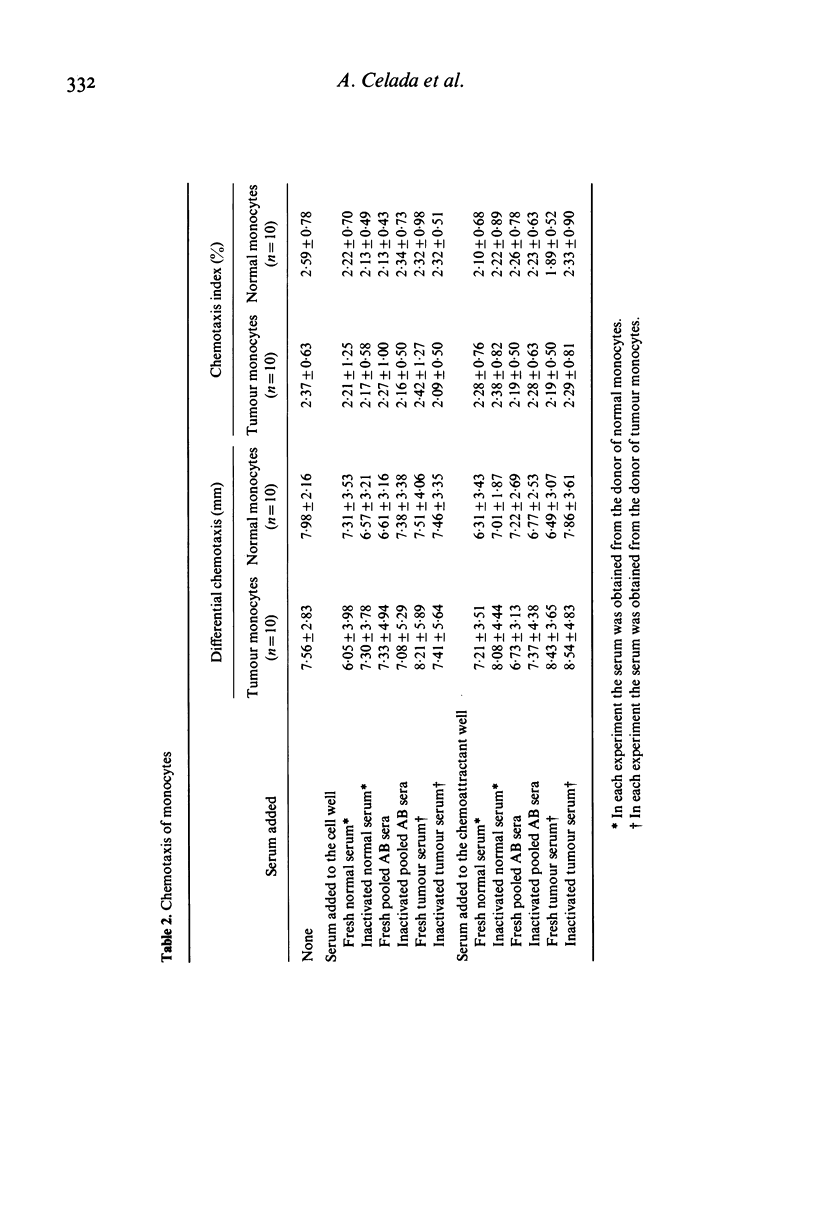

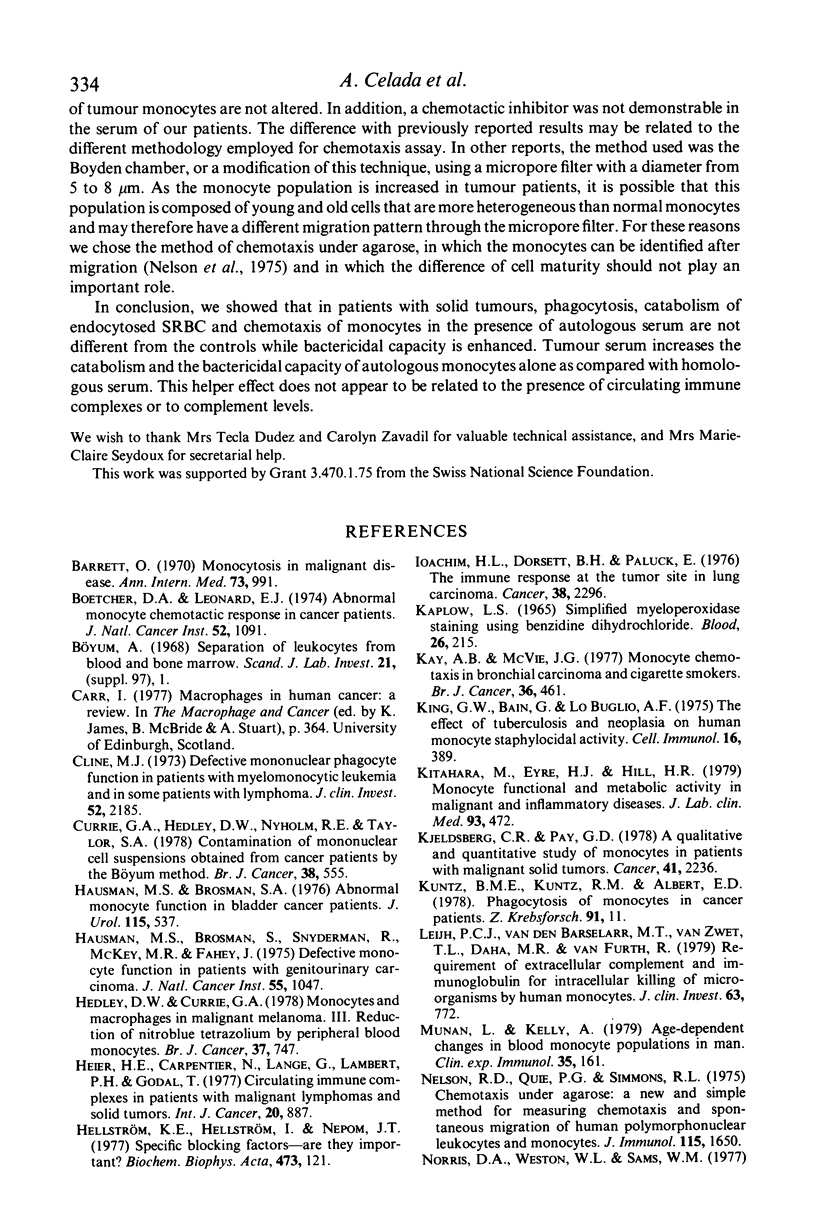
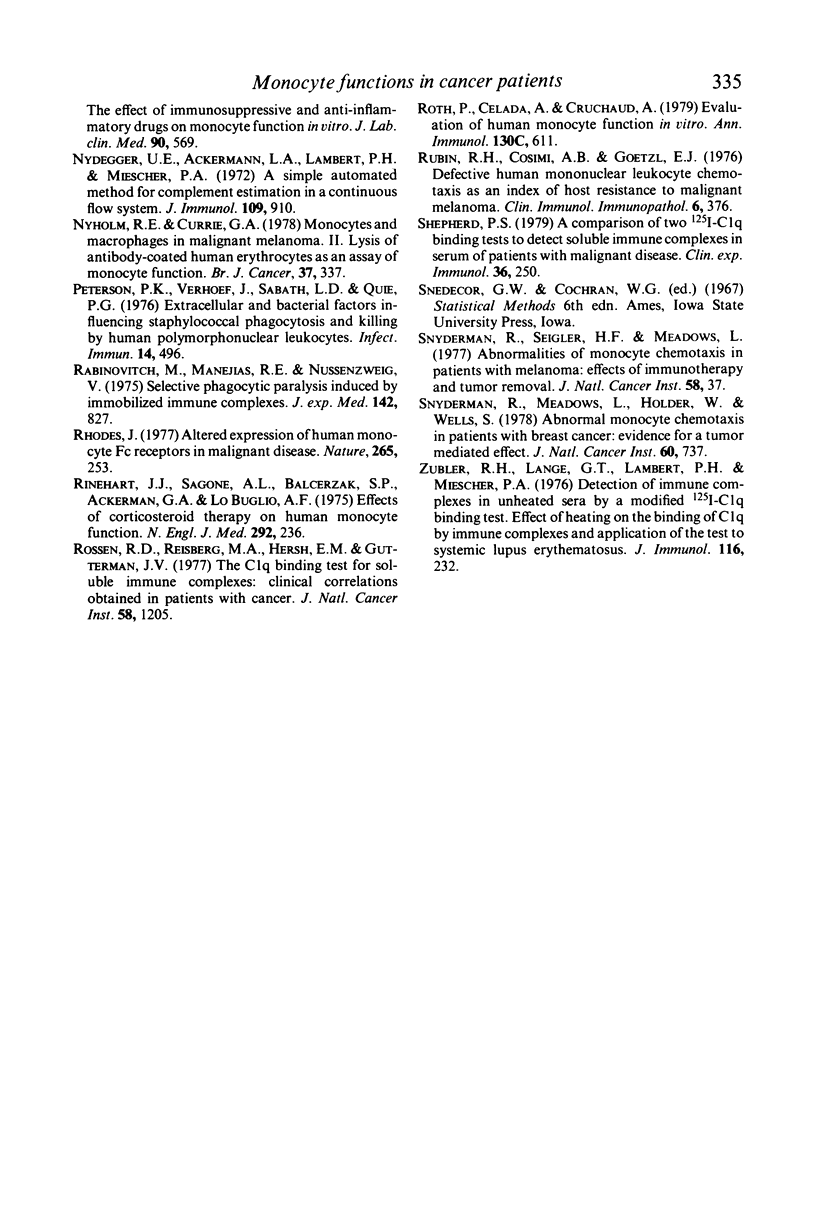
Selected References
These references are in PubMed. This may not be the complete list of references from this article.
- Barrett O., Jr Monocytosis in malignant disease. Ann Intern Med. 1970 Dec;73(6):991–992. doi: 10.7326/0003-4819-73-6-991. [DOI] [PubMed] [Google Scholar]
- Boetcher D. A., Leonard E. J. Abnormal monocyte chemotactic response in cancer patients. J Natl Cancer Inst. 1974 Apr;52(4):1091–1099. doi: 10.1093/jnci/52.4.1091. [DOI] [PubMed] [Google Scholar]
- Cline M. J. Defective mononuclear phagocyte function in patients with myelomonocytic leukemia and in some patients with lymphoma. J Clin Invest. 1973 Sep;52(9):2185–2190. doi: 10.1172/JCI107403. [DOI] [PMC free article] [PubMed] [Google Scholar]
- Currie G. A., Hedley D. W., Nyholm R. E., Taylor S. A. Contamination of mononuclear cell suspensions obtained from cancer patients by the Böyum method. Br J Cancer. 1978 Oct;38(4):555–556. doi: 10.1038/bjc.1978.244. [DOI] [PMC free article] [PubMed] [Google Scholar]
- Hausman M. S., Brosman S. A. Abnormal monocyte function in bladder cancer patients. J Urol. 1976 May;115(5):537–541. doi: 10.1016/s0022-5347(17)59271-x. [DOI] [PubMed] [Google Scholar]
- Hausman M. S., Brosman S., Snyderman R., Mickey M. R., Fahey J. Defective monocyte function in patients with genitourinary carcinoma. J Natl Cancer Inst. 1975 Nov;55(5):1047–1054. doi: 10.1093/jnci/55.5.1047. [DOI] [PubMed] [Google Scholar]
- Hedley D. W., Currie G. A. Monocytes and macrophages in malignant melanoma. III. Reduction of nitroblue tetrazolium by peripheral blood monocytes. Br J Cancer. 1978 May;37(5):747–752. doi: 10.1038/bjc.1978.113. [DOI] [PMC free article] [PubMed] [Google Scholar]
- Heier H. E., Carpentier N., Lange G., Lambert P. H., Godal T. Circulating immune complexes in patients with malignant lymphomas and solid tumors. Int J Cancer. 1977 Dec 15;20(6):887–894. doi: 10.1002/ijc.2910200611. [DOI] [PubMed] [Google Scholar]
- Hellström K. E., Hellström I., Nepom J. T. Specific blocking factors--are they important? Biochim Biophys Acta. 1977 Dec 23;473(2):121–148. doi: 10.1016/0304-419x(77)90003-8. [DOI] [PubMed] [Google Scholar]
- Ioachim H. L., Dorsett B. H., Paluch E. The immune response at the tumor site in lung carcinoma. Cancer. 1976 Dec;38(6):2296–2309. doi: 10.1002/1097-0142(197612)38:6<2296::aid-cncr2820380617>3.0.co;2-1. [DOI] [PubMed] [Google Scholar]
- KAPLOW L. S. SIMPLIFIED MYELOPEROXIDASE STAIN USING BENZIDINE DIHYDROCHLORIDE. Blood. 1965 Aug;26:215–219. [PubMed] [Google Scholar]
- Kay A. B., McVie J. G. Monocyte chemotaxis in bronchial carcinoma and cigarette smokers. Br J Cancer. 1977 Oct;36(4):461–466. doi: 10.1038/bjc.1977.215. [DOI] [PMC free article] [PubMed] [Google Scholar]
- King G. W., Bain G., LoBuglio A. F. The effect of tuberculosis and neoplasia on human monocyte staphylocidal activity. Cell Immunol. 1975 Apr;16(2):389–395. doi: 10.1016/0008-8749(75)90127-6. [DOI] [PubMed] [Google Scholar]
- Kitahara M., Eyre H. J., Hill H. R. Monocyte functional and metabolic activity in malignant and inflammatory diseases. J Lab Clin Med. 1979 Mar;93(3):472–479. [PubMed] [Google Scholar]
- Kjeldsberg C. R., Pay G. D. A qualitative and quantitative study of monocytes in patients with malignant solid tumors. Cancer. 1978 Jun;41(6):2236–2241. doi: 10.1002/1097-0142(197806)41:6<2236::aid-cncr2820410624>3.0.co;2-m. [DOI] [PubMed] [Google Scholar]
- Leijh P. C., van den Barselaar M. T., van Zwet T. L., Daha M. R., van Furth R. Requirement of extracellular complement and immunoglobulin for intracellular killing of micro-organisms by human monocytes. J Clin Invest. 1979 Apr;63(4):772–784. doi: 10.1172/JCI109362. [DOI] [PMC free article] [PubMed] [Google Scholar]
- Munan L., Kelly A. Age-dependent changes in blood monocyte populations in man. Clin Exp Immunol. 1979 Jan;35(1):161–162. [PMC free article] [PubMed] [Google Scholar]
- Nelson R. D., Quie P. G., Simmons R. L. Chemotaxis under agarose: a new and simple method for measuring chemotaxis and spontaneous migration of human polymorphonuclear leukocytes and monocytes. J Immunol. 1975 Dec;115(6):1650–1656. [PubMed] [Google Scholar]
- Norris D. A., Weston W. L., Sams W. M., Jr The effect of immunosuppressive and anti-inflammatory drugs on monocyte function in vitro. J Lab Clin Med. 1977 Sep;90(3):569–580. [PubMed] [Google Scholar]
- Nydegger U. E., Achermann L. M., Lambert P. H., Miescher P. A. A simple automated method for complement estimation in a continuous flow system. J Immunol. 1972 Oct;109(4):910–913. [PubMed] [Google Scholar]
- Nyholm R. E., Currie G. A. Monocytes and macrophages in malignant melanoma. II. Lysis of antibody-coated human erythrocytes as an assay of monocyte function. Br J Cancer. 1978 Mar;37(3):337–344. doi: 10.1038/bjc.1978.52. [DOI] [PMC free article] [PubMed] [Google Scholar]
- Peterson P. K., Verhoef J., Sabath L. D., Quie P. G. Extracellular and bacterial factors influencing staphylococcal phagocytosis and killing by human polymorphonuclear leukocytes. Infect Immun. 1976 Aug;14(2):496–501. doi: 10.1128/iai.14.2.496-501.1976. [DOI] [PMC free article] [PubMed] [Google Scholar]
- Rabinovitch M., Manejias R. E., Nussenzweig V. Selective phagocytic paralysis induced by immobilized immune complexes. J Exp Med. 1975 Oct 1;142(4):827–838. doi: 10.1084/jem.142.4.827. [DOI] [PMC free article] [PubMed] [Google Scholar]
- Rhodes J. Altered expression of human monocyte Fc receptors in malignant disease. Nature. 1977 Jan 20;265(5591):253–255. doi: 10.1038/265253a0. [DOI] [PubMed] [Google Scholar]
- Rinehart J. J., Sagone A. L., Balcerzak S. P., Ackerman G. A., LoBuglio A. F. Effects of corticosteroid therapy on human monocyte function. N Engl J Med. 1975 Jan 30;292(5):236–241. doi: 10.1056/NEJM197501302920504. [DOI] [PubMed] [Google Scholar]
- Rossen R. D., Reisberg M. A., Hersh E. M., Gutterman J. U. The C1q binding test for soluble immune complexes: clinical correlations obtained in patients with cancer. J Natl Cancer Inst. 1977 May;58(5):1205–1215. doi: 10.1093/jnci/58.5.1205. [DOI] [PubMed] [Google Scholar]
- Rubin R. H., Cosimi A. B., Goetzl E. J. Defective human mononuclear leukocyte chemotaxis as an index of host resistance to malignant melanoma. Clin Immunol Immunopathol. 1976 Nov;6(3):376–388. doi: 10.1016/0090-1229(76)90091-x. [DOI] [PubMed] [Google Scholar]
- Shepherd P. S. A comparison of two 125I C1q binding tests to detect soluble immune complexes in serum of patients with malignant disease. Clin Exp Immunol. 1979 May;36(2):250–255. [PMC free article] [PubMed] [Google Scholar]
- Snyderman R., Meadows L., Holder W., Wells S., Jr Abnormal monocyte chemotaxis in patients with breast cancer: evidence for a tumor-mediated effect. J Natl Cancer Inst. 1978 Apr;60(4):737–740. doi: 10.1093/jnci/60.4.737. [DOI] [PubMed] [Google Scholar]
- Snyderman R., Seigler H. F., Meadows L. Abnormalitieis of monocyte chemotaxis in patients with melanoma: effects of immunotherapy and tumor removal. J Natl Cancer Inst. 1977 Jan;58(1):37–41. doi: 10.1093/jnci/58.1.37. [DOI] [PubMed] [Google Scholar]
- Zubler R. H., Lange G., Lambert P. H., Miescher P. A. Detection of immune complexes in unheated sera by modified 125I-Clq binding test. Effect of heating on the binding of Clq by immune complexes and application of the test to systemic lupus erythematosus. J Immunol. 1976 Jan;116(1):232–235. [PubMed] [Google Scholar]


